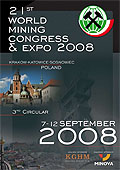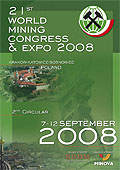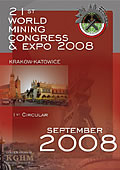Discover Kraków
 Welcome to Krakow, a city wrapped in legend, where time flows differently, and where every moment becomes a moment of history. For centuries Krakow was the capital of Poland, the seat of kings, drawing great scholars and artists from the whole world. It is their talents and imagination we must thank for the city's rich legacy of unique historical relics, which reflect the most important trends in European culture.
Welcome to Krakow, a city wrapped in legend, where time flows differently, and where every moment becomes a moment of history. For centuries Krakow was the capital of Poland, the seat of kings, drawing great scholars and artists from the whole world. It is their talents and imagination we must thank for the city's rich legacy of unique historical relics, which reflect the most important trends in European culture.
The renaissance Royal Castle at Wawel, the gothic St Mary's Basilica, the historical trade pavilions of the Cloth Hall, the former separate Jewish city of Kazimierz, and even the Nowa Huta district, absorbed by Krakow together with its socialist-realist, industrial architecture, are all places which make a visit to Krakow extremely worthwhile.
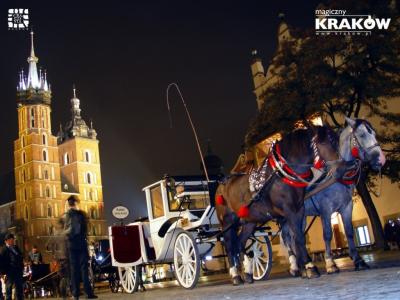
Although the city no longer plays such an important administrative role, for many people, thanks to its rich history, Krakow nevertheless represents a synthesis of all things Polish, connecting tradition with modernity. In the special atmosphere of the beautiful and mysterious streets of the Old Town and Kazimierz you will find everything you need to allow you to escape from everyday life. Galleries full of exhibitions, cafes, pubs and restaurants: all of this is an integral part of any visit to Krakow. And all this is merely a modest part of what we can offer travellers seeking exciting destinations on the world map.
Location
Krakow lies in the southern part of Poland on the Vistula River in a valley at the foot of the Carpathian Plateau, 219 meters above sea level. Approximately 300 km (190 miles) north is Warsaw, the capital of Poland, and 100 km (60 miles) south are the Tatra Mountains, forming the southern border of the country. The city covers an area of 327 sq. km, equal to 0.1% of the country's surface area.
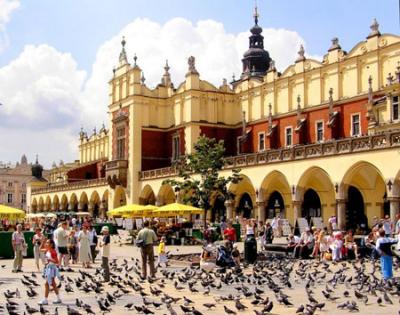
Natural Environment
The landscape and its geological structure are very diverse, both in Krakow and its vicinity. In many areas one may come across picturesque karst formations that evolved from Jurassic limestone. Fertile loess clays are located in the northeast. South of the Vistula River there are undulating areas of loamy sandstone and in the southeast lie layers of salt.
Traditions: THE LAJKONIK FESTIVITIES
Annually, every first Thursday following Corpus Christi day a large crowd of people gathers in the Premonstratensian monastery yard in the Zwierzyniec district. Some men are dressed in the traditional Cracovian folklore dress while others are adorned by oriental garments and hold horse-tail insignia in their hands. A musical troupe called "The Mlaskoty" stands close by playing drums, flute bugle, clarinet, fiddle, and double-bass.
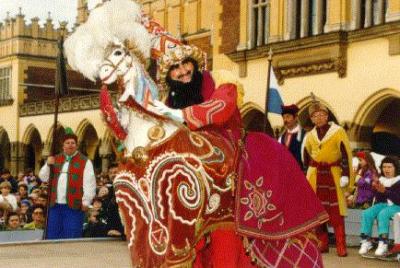
The "Lajkonik" enters the yard while the troupe plays loud and high-pitched music. The hero of the festivity - Lajkonik - rides a hobby horse with peacock feathers attached to its head and dressed in Tartar 'disguise' through the streets of Krakow. This magnificent costume is a faithful copy of the dress designed by Stanisław Wyspiański in 1904. After paying a courteous visit to the Premonstratensian monastery and parish priest the Lajkonik leads the pageant through the streets of Krakow: Kościuszki, Zwierzyniecka, Franciszkańska, and Grodzka to the Main Square. This procession lasts about 2-3 hours. At 6 p.m., in front of the Old Tower Hall at the Main Square, the Lajkonik, with colours flying and music blasting, dances and prances merrily around. Dinner at the Hawełka restaurant usually ends the festivities.
Traditions: RĘKAWKA
This is a type of outdoor fair and market which takes place on Tuesday after Easter in the vicinity of the Benedictine Church atop of Lasota Hill in Podgórze. Today this festivity is usually limited to stands selling gingerbread, sweets, cheap souvenirs and toys, along with some shooting galleries and a fun fair. In the past it was different. According to the 1475 Hetman Volumes, Stanisław Sarnicki describes the ancient tradition of planting trees around the grave of Rękawka, as well as bonfires and fencing. The name "Rękawka" is quite probably derived from the world "rękaw" meaning sleeve - referring to the sleeves in which people carried soil to the grave of Krakus. The festivities were transferred from the foot of the Krakus Mound after Krakow was annexed by Austria. In the old times, the poor were given food, but Austrian authorities forbade this in 1897, and the fair is all that remains of the tradition.
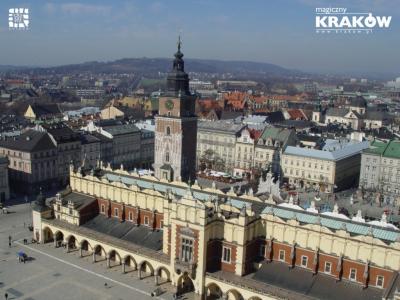
Traditions: THE EMAUS
On Easter Monday at the Church of St. Salwator in Zwierzyniec, the passage in St. Luke's gospel about the pupils of Emaus is read aloud from the pulpit: "And behold, two of them travelled to the town called Emaus as far as 60 stadiums from Jerusalem. Between themselves they talked of all things that ever happened. Then it occurred that while they were talking Jesus approached and walked with them. Their eyes were veiled so they could not recognise Him. [...]." This church was named Emaus a long time ago, or the more familiar "Hemaus". This festivity is an occasion for large crowds of Cracovians and visitors to attend the folk garden party and fair. Fair stands and stalls are set up along the whole length of the Kościuszko Street reaching the bridge over the Rudawa River. And because Easter Monday is called "Wet Monday", hordes of passers-by are soaked in water. Since 1976, the Emaus festivity has been organised under the auspices of the Krakow Historical Museum.
Traditions: FLOATING OF THE WREATHS
Every year on St. John the Baptist's Day and Wanda's name day (June 23-24) the tradition of Wreaths is celebrated along the Vistula River banks at the foot of Wawel Hill. This festivity changed somewhat after the Second World War. However, the common elements are amateur and professional folklore group performances on a stage erected close to Wawel Castle, floating lit wreaths on the Vistula River, and a fireworks display.
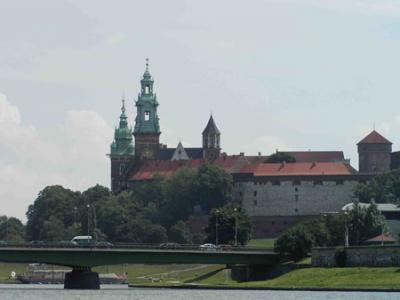
Annually, this event gathers enormous numbers of Cracovians and guests between Wawel and the Dębnicki Bridge. The genesis of this tradition is ancient and a sum of three customs: Sobótka, bonfires traditionally lit by country folk on Midsummer Day, the search for the magical fern flower and a commemoration of Wanda - legendary daughter of Krakus.
Traditions: ENTHRONING OF THE RIFLE CLUB CHAMPION
As Spring approaches "The Rifle Club Brotherhood" begins to prepare for the royal shooting contest. The Royal Council nominates candidates (usually several men) to take part in the competition. The shooting gallery is located on Wrocławska Street at the military shooting grounds. In the second half of May, the candidates arrive at the contest dressed in historical costumes - a żupan and kontusz bound with a wide ornamental belt, a hat with a crane's feather and red boots (żupan - Polish nobleman's national costume; kontusz - ancient robe of Polish nobility).
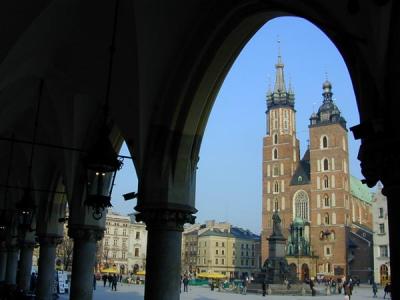
The three best contestants participate in the final shooting. Their target is a wooden rooster. The rifleman who shoots off the last piece of the rooster is the champion. The crowning of the champion occurs during the last days of the Krakow Festival. The ceremony is accompanied by a colourful pageant meandering among passers-by in the Main Square and heading towards the Old Town Hall tower, where exactly at noon, the new rifle champion is crowned.
Traditions: THE CRIBS EXHIBITION
During the first ten days of December Cracovian crib makers surround the statue of Adam Mickiewicz at the Main Square to present dozens of cribs. Some are small, others are huge. Traditionally, a majority of the cribs are imitations of Krakow's monumental buildings. This very colourful spectacle always draws a crowd. The first crib competition took place in 1937. At exactly 12 o'clock, after the bugle call is sounded from St. Mary's Church tower the exhibition comes to an end. Picking up their masterpieces, the crib makers march to the Krakow Historical Museum.
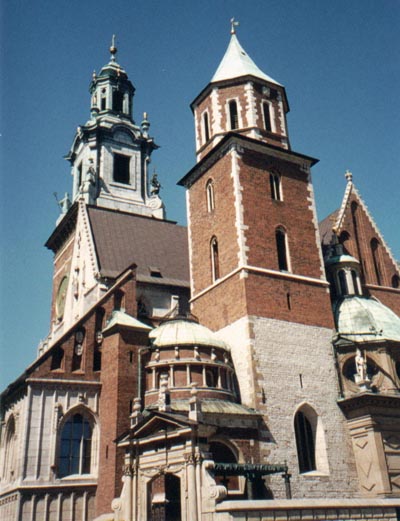
The best cribs are then purchased by the museum. The makers of cribs are usually Cracovian bricklayers from the outskirts of Krakow, especially Krowodrza, Zwierzyniec, and Grzegórzki. They make cribs for money while they are out of work in autumn. The most outstanding crib maker was a bricklayer from Krowodrza, Michał Ezenkier, who created his own style, copied today by many followers.
Traditions: THE BUGLE CALL
This is one of the most remarked upon peculiarities of Krakow. Every hour on the hour, a bugle is played from the top of St. Mary's Church tower. This bugle call is transmitted by Polish Radio at midday, every day. In the past, the bugle player announced the opening and closing of the city gateways. It is not known when the decision was made for the bugle to be sounded four times every hour towards the north, south, east and west. The bugle call returned in 1810 after a short break (and a break during the World War Two German occupation).

Traditions: OMNIBUS
During the summer tourist season an authentic attraction is to board an old horse-drawn omnibus - the first public transport vehicle in the city. The omnibuses run along the route from the Barbican to Wawel Castle.
Traditions: THE ENCHANTED CABBY
The single, horse-drawn cabs, as city transportation means, officially appeared on the streets of Krakow in March 1855. During his many visits to Krakow, a well-known Polish poet Konstanty Ildefons Gałczyński often used the number 13 cab owned by Jan Kaczara. The poem "The enchanted Cabby" made Gałczyński very popular. Today, the tradition of the Cracovian cab (commemorated in many films and paintings) is continued by the sons of Kaczara, who today drive their cabs with a number 6.

